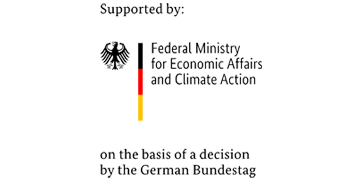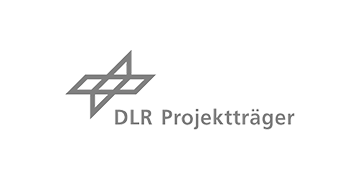| Theme | Additive Manufacturing |
|---|---|
| Project title | Optical quality control for extrusion 3D printing (Quali3D) |
| Project duration | 01.07.2019 – 30.09.2021 |
| Video | |
| Results | |
| Download | |
| Press release |
Additive manufacturing is a fast-growing market. Especially for small and medium-sized companies extrusion based additive manufacturing is interesting due to the large number of processable materials and application areas. However, as a supplement to existing manufacturing technologies a nationwide use of extrusion based additive manufacturing is not in progress. Deficits in the knowledge of process qualities and control variables lead to quality problems and a lack of acceptance regarding to the technology. In addition, with today's 3d-printers process errors will not be detected or only after the completion of a part.
The aim of this research project is to assure the additive manufacturing process with optical measuring technology. The inline quality assurance system works layer by layer. The project will contribute to the further industrialization of additive manufacturing.
- Sorry, no events available.
- 09.09.2021
- Videokonferenz
- 18.02.2021
- Videokonferenz
- 15.05.2020, 13:30 h - 16:00 h
- IPH Hannover gGmbH | Hollerithallee 6 | 30419 Hannover
- 13.09.2019, 10:30 h - 14:30 h
- IPH Hannover gGmbH, Hollerithallee 6, 30419 Hannover
Publications about the project
Tools for implementing a systematic quality management are necessary for the use of material extrusion as an additive manufacturing process for products with high quality requirements. Well-defined quality classes are crucial for ensuring that the requirements for a product can be communicated transparently and that the existing properties can be evaluated. Furthermore, there is a lack of capable measurement equipment for the acquisition of process data during the production process. To address these challenges, the present paper introduces an image processing system that determines quality indicators for individual layers in terms of imperfect surface percentages and the number of imperfections. The central element of the hardware is an adaptive darkfield illumination, which leads to high-contrast images. In addition, five types of layer subareas are identified in a segmentation step. Unsupervised machine learning methods are then used to detect imperfections in each layer subarea. In the segmentation, the current layer can be distinguished from irrelevant image background regions with an F-measure of 0.981. For the layer-wise measurement of the quality indicators, relative measurement errors with standard deviations of 25 to 76.1% are found. After evaluating the capabilities of the image processing system, a proposal for limits of quality classes is derived by monitoring several material extrusion processes. For this purpose, three quality classes for each of the five layer subareas are deduced from the process scatter measured by the image processing system. The results are an important contribution to the industrialization of material extrusion in safety–critical areas such as medical technology or the aerospace industry.
additive manufacturing, material extrusion, quality classes, image processing, Process monitoring
The ongoing industrialization of material extrusion additive manufacturing requires tools for the acquisition of condition data for the formalized evaluation of process qualities. However, current approaches for process monitoring are not sufficient regarding the needed flexibilities and capabilities for interpreting process data. Therefore, in this thesis it is investigated to what extent quality indicators for material extrusion can be derived based on self-learning image processing methods for a layer-by-layer anomaly detection and an evaluation of the digital part information.
For this purpose, the optical properties of layer surfaces are analyzed and an image processing system is developed on this basis. To include digital part information in the image processing steps, the NC program for the machine control is analyzed. Furthermore, different layer areas are detected in segmentation steps, characteristic feature vectors for layer surfaces are extracted and unsupervised machine learning methods are used to detect imperfections. Finally, quality indicators for the area and the number of layer imperfections are determined. The evaluation of the image processing system based on a realistic data set and shows that influences of an illumination are significant and can be partially represented in a model. Additionally, uncertainties of digital part information occurring in manufacturing practice are quantified. Furthermore, a proposal for quality classes is derived from an empirical field study.
additive manufacturing, material extrusion, quality indicators, quality classes, image processing
Qualitative uncertainties are a key challenge for the further industrialization of additive manufacturing. To solve this challenge, methods for measuring the process states and properties of parts during additive manufacturing are essential. The subject of this review is in-situ process monitoring for material extrusion additive manufacturing. The objectives are, first, to quantify the research activity on this topic, second, to analyze the utilized technologies, and finally, to identify research gaps. Various databases were systematically searched for relevant publications and a total of 221 publications were analyzed in detail. The study demonstrated that the research activity in this field has been gaining importance. Numerous sensor technologies and analysis algorithms have been identified. Nonetheless, research gaps exist in topics such as optimized monitoring systems for industrial material extrusion facilities, inspection capabilities for additional quality characteristics, and standardization aspects. This literature review is the first to address process monitoring for material extrusion using a systematic and comprehensive approach.
Material extrusion, Fused deposition modeling, Process monitoring, Sensor technology, Research gaps
Quality assurance methods are a central success factor for the further industrialization of additive manufacturing. This paper presents an approach for an optical inspection system that controls the quality of additive material extrusion layer by layer. The inspection task gets analyzed, hardware components for data acquisition are designed and a first step towards texture-analytical detection of defects is presented.
additive manufacturing, 3d printing, material extrusion, fused deposition modeling, image processing
Quality assurance methods are a central success factor for the further industrialization of additive manufacturing. In the IGF research project "Optical quality inspection for extrusion 3D printing (Quali3D)", a testing system is therefore being developed which monitors the quality of the additive process layer by layer. This should enable a comprehensive evaluation.
3D printing, additive manufacturing, optical metrology, image processing












